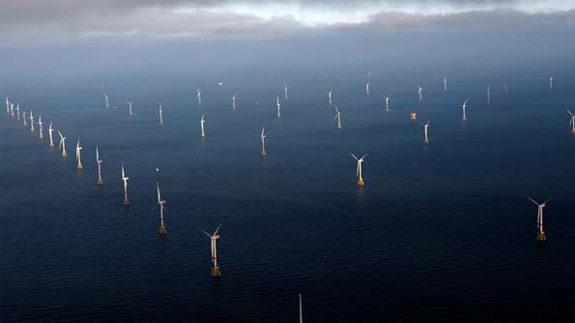The Dogger Bank Teesside A and B project would see as many as 400 wind turbines built around 100 miles off England’s North East coast, if it is completed after it gained planning consent.
In February a similar sized scheme, also at Dogger Bank, was granted planning consent.
Put together, the two adjacent projects would be the world’s biggest offshore wind farm.
The development by the Forewind consortium of SSE, RWE, Statkraft and Statoil would have an onshore elements in Redcar and Cleveland, near Middlesbrough.
Forewind general manager, Tarald Gjerde said: “It represents a real opportunity for the UK to receive even more of its energy from its abundant wind resource while creating significant economic benefits, particularly for the north eastern regions.”
Forewind said the Teesside A and B projects could create 4,750 direct and indirect jobs, generating £1.5 billion for the UK economy.
Seabed conditions and wind speed and shallow waters make it ideally suited to power generation, the consortium said.
Energy and Climate Change Minister Lord Bourne said: “Thanks to Government support the UK is the world leader in offshore wind energy.
“As we build the Northern Powerhouse, we want local communities to reap the benefits of investment and green jobs from low carbon developments like Dogger Bank Offshore wind project.”
As well as the turbines, the project could see eight collector platforms built, four accommodation or helicopter platforms, 10 weather stations and two converter stations.
The electricity would be brought via up to two sets of export cables to a landing point between Redcar and Marske-by-the-Sea and then fed into the National Grid.
RenewableUK, which represents the renewable energy industry, said the development would cover an area of seabed of around 600 square km.
Its chief executive, Maria McCaffery said: “This awe-inspiring offshore wind project has taken another significant step forward.
“The sheer size of Dogger Bank illustrates just how large the environmental and economic opportunities are in the North Sea for the UK’s world-leading offshore wind industry.”
RenewableUK demanded that the Government, which has recently announced reductions in green power subsidies, should support the industry.
Ms McCaffery said: “The industry is set to play its part – but it needs a fair wind from Westminster in order to do so”.
A spokesman from Friends of the Earth said: “Renewable energy like offshore wind is the opportunity of the century for the UK and it’s exciting to see projects getting consent, but Dogger Bank will only get built if the Government stops its attacks on the green economy and provides a stable policy environment.
“The UK has been a world leader in offshore wind, but the Treasury’s hostility to renewable energy mean it risks rapidly falling behind. This year Germany could overtake the UK as Europe’s largest offshore wind market.
“As the US and China announce huge investments in renewables, David Cameron is going to have to work really hard to show the world that the UK has not turned its back on renewable energy and maintain his credibility at the climate talks in Paris.”
Trawlermen have concerns about how their industry will be able to work alongside huge wind farms, a senior figure in the National Federation of Fishermen’s Organisations (NFFO) said.
Dogger Bank, a large area of sand banks, is an important site for plaice and sand eel fishing and is a marine protected area.
NFFO assistant chief executive Dale Rodmell said: “Our main concern is ensuring as far as possible that fisheries can co-exist with wind farm sites.
“There is a large degree of uncertainty and we have very little experience as the UK is leading the world to drive the offshore wind industry.”
Although in theory fishing between turbines would be allowed, Mr Rodmell said, in practice concerns over the spacing between them and nets snagging on cables could rule it out.
A Forewind spokeswoman said environmental assessments had been carried out by the developers, and measures would be taken to mitigate any impact.
She said the Secretary of State would have taken those concerns into consideration before granting planning consent.



